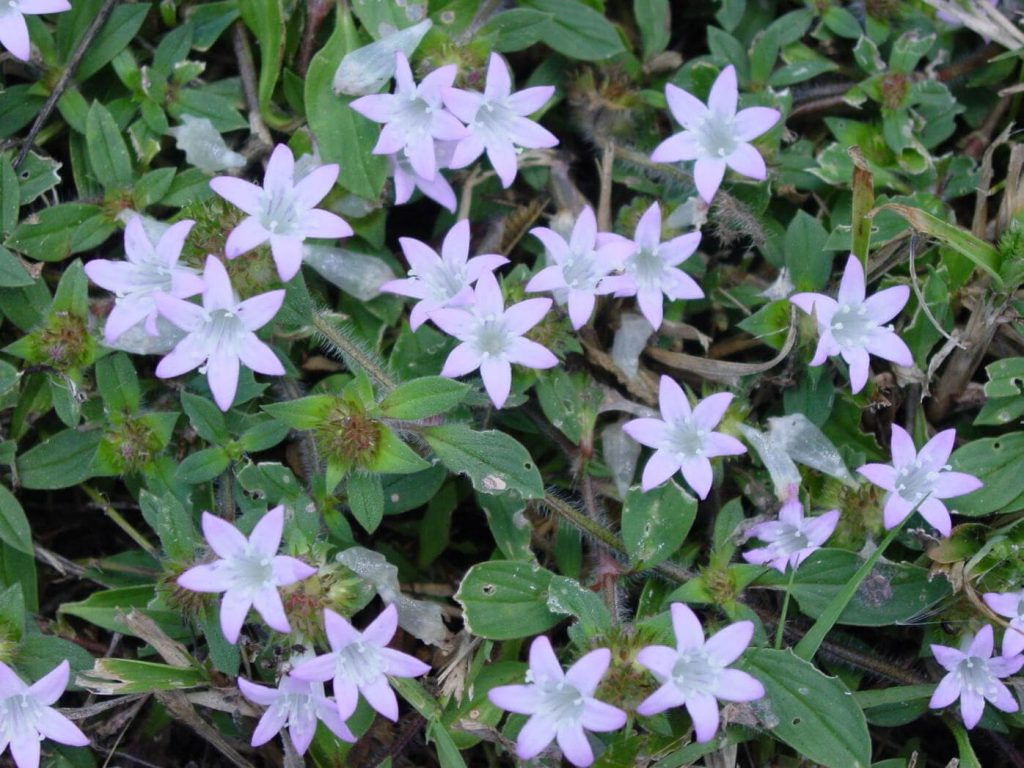
I wrote about this relatively new weed a few years ago and it has made an appearance once again! You may have seen what looks like swathes of “light snow” on medians, the sides of roads and local yards. What you are actually seeing is a plant called large-flower pusley. This is not a very attractive name for such a “lovely” weed. In fact, it is a weed in lawns, but many people have grown to like large-flower pusley and even ask where they can buy it! Flowering now as a holiday reminder of the real snow up north, what is this curious plant?
Like many weeds which are often just plants out of place, large-flower pusley is from somewhere else — South America this time. Botanically, large-flower pusley is known as Richardia grandiflora. Other names have included “Florida Snow” and “Mexican Clover.” This plant is a perennial which lives year after year and reproduces via seeds and pieces of the stem likely spread by human activity — mostly lawn mowers. As it creeps and spreads, this plant roots at the nodes of the sprawling stems. It is flowering heavily now and will continue on into January to the joy of local butterflies and bees. The flowers are six-petalled and star-like in appearance, arranged in clusters of pink, white, blue, and/or lavender. The flowers close up for the night, but sunlight makes them open in seemingly endless stretches of flowers — literally for miles. The Florida Exotic Pest Plant Council lists large-flower pusley as a Category II Invasive plant which “have increased in abundance or frequency but have not yet altered Florida plant communities to the extent shown by Category I species. These species may become ranked Category I if ecological damage is demonstrated.” If you look around, the large-flower pusley “horse” is definitely already out of the barn!
You can take large- flower pusley a number of ways. You might do nothing and live with it as a drought-tolerant plant that does well in poor soils where other plants (turf) may not do well. So, for some people it has become a seasonal flowering groundcover. If you would like to control it in your St. Augustine grass only, (not Bahia grass), the herbicide atrazine can be used as per label directions — read the label, it is the law! If a majority of the turf is covered with large-flower pusley, you may need to total kill the area with glyphosate and start over. Weeds such as this infest weakened turf stressed due to factors such as scalping, improper irrigation, improper fertilization, etc., so be careful with turf cultural practices to help suppress this weed.
In lawns that are not doing well already, an infestation of large-flower pusley may be a welcome, seasonal change. Keep in mind, in no way am I recommending this weed for any purpose. However, if your lawn is a “lemon” already, perhaps let this cheery weed help you make “lemonade” out of the space for the time being!
For more information on both weeds and groundcovers, and how to tell the difference between the two, please call our Master Gardener volunteers on the Plant Lifeline on Mondays, Wednesdays and Fridays from 1 p.m. to 4 p.m. at 941-764-4340 for gardening help and insight into their role as an extension volunteer.
 3
3
